Kristine Hughes's Blog, page 85
October 29, 2014
NEW EXHIBIT AT THE METROPOLITAN MUSEUM OF ART

Death Becomes Her: A Century of Mourning Attire
October 21, 2014-February 1, 2015
The Costume Institute’s first fall exhibition in seven years, is on view in The Metropolitan Museum of Art’s Anna Wintour Costume Center from October 21, 2014, through February 1, 2015. The exhibition explores the aesthetic development and cultural implications of mourning fashions of the 19th and early 20th centuries. Approximately 30 ensembles, many of which are being exhibited for the first time, reveal the impact of high-fashion standards on the sartorial dictates of bereavement rituals as they evolved over a century.
With the reopening of The Costume Institute space in May as the Anna Wintour Costume Center, the department returns to mounting two special exhibitions a year, once again including a fall show, in addition to the major spring exhibition. This is the first fall exhibition The Costume Institute has organized since blog.mode: addressing fashion in 2007.
“The predominantly black palette of mourning dramatizes the evolution of period silhouettes and the increasing absorption of fashion ideals into this most codified of etiquettes,” said Harold Koda, Curator in Charge of The Costume Institute, who is curating the exhibition with Jessica Regan, Assistant Curator. “The veiled widow could elicit sympathy as well as predatory male advances. As a woman of sexual experience without marital constraints, she was often imagined as a potential threat to the social order.”
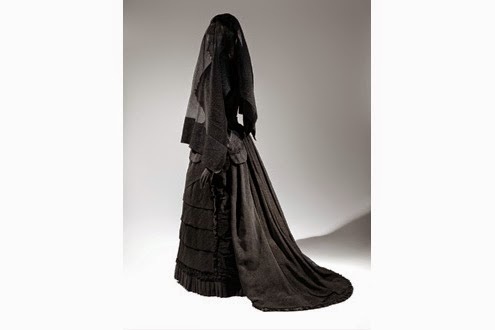
Exhibition Overview
The thematic exhibition is organized chronologically and features mourning dress from 1815 to 1915, primarily from The Costume Institute’s collection. The calendar of bereavement’s evolution and cultural implications are illuminated through women’s clothing and accessories, showing the progression of appropriate fabrics from mourning crape to corded silks, and the later introduction of color with shades of gray and mauve.
“Elaborate standards of mourning set by royalty spread across class lines via fashion magazines,” said Ms. Regan, “and the prescribed clothing was readily available for purchase through mourning ‘warehouses’ that proliferated in European and American cities by mid-century.”
The Anna Wintour Costume Center’s Carl and Iris Barrel Apfel Gallery orients visitors to the exhibition with fashion plates, jewelry, and accessories. The main Lizzie and Jonathan Tisch Gallery illustrates the evolution of mourning wear through high fashion silhouettes and includes mourning gowns worn by Queen Victoria and Queen Alexandra. Examples of restrained simplicity are shown alongside those with ostentatious ornamentation. The predominantly black clothes are set off within a stark white space amplified with historic photographs and daguerreotypes.
Related Programs
In conjunction with the exhibition, a Halloween event on October 31, 6:30–8:30 p.m., will encourage visitors to chart their own path through the galleries and join drop-in,
interactive experiences with art. Ms. Regan will give a Friday Focus lecture, Women in Black: Fashioning Mourning in the 19th Century, on Friday, November 21, at 4:00 p.m. Musical programming includes a special pop-up concert featuring Icelandic cellist Hildur Guðnadóttir on October 17 at 6:00 p.m., and a performance by vocalist Theo Bleckmann on February 7 at 7:00 p.m.The Museum’s website, www.metmuseum.org/deathbecomesher, features information on the exhibition and related programs.
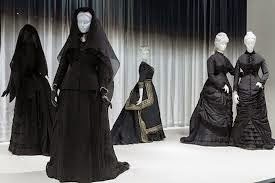
Click here for a review of the Death Becomes Her by Elle Magazine
Harper's Bazaar reviews the show here and includes a slideshow of the best mourning costumes in film.
Published on October 29, 2014 00:00
October 27, 2014
LOOSE IN LONDON: KRISTINE'S FIRST DAY - PART ONE
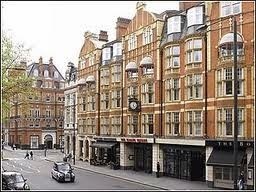
I arrived at our hotel early from the airport – before 9 a.m., and so our room wasn’t ready. In fact, I was told that it wouldn’t be ready till closer to 2 p.m. I left Big Red and my carry-on bags with the hotel and crossed Sloane Square to Duke of York Square, which was deserted save for one or two coffee places that were already open – not, alas, a Café Nero in sight. So I bought a coffee and sauntered around the Square as well as a limping person with sore feet can saunter. Being that I was unable to affect a careless Bertie Wooster type of saunter, I had no choice but to settle for more of a Boris Karloff as the Mummy sort of gait. I would have been happy to walk the entire length of the King’s Road and back again in order to kill time, as there’s nothing I love more than strolling the streets of London, whether I have a firm destination or no. However, my feet weren’t going to cooperate so I sat for a while on a bench and watched the passing parade of people. Note to self and you: almost every woman who walked past me, regardless of age or profession, was wearing ballet flats and a short, black leather jacket. Ergo, buy short, black leather jacket as it will no doubt be the next big thing this season.
Whenever I travel to Englandwith my daughter, Brooke, we spend the first few hours after our arrival marveling at the fact that we’re in England. “Look!” we’ll cry, “an English dog!” “Look, an English postbox!” “Look, an English Starbucks!” “Look, a black cab!” I soon found this exercise was much less fun when played by oneself and so gave it up fairly quickly. Finishing my coffee, I summoned my determination, defied the pain and began the walk from King’s Road down to the Royal Chelsea Hospital. Despite knowing well its Wellington connections, I’d never visited before and so had planned to rectify this gap on this day, prior to Victoria’s arrival. No time like the present.
I slow walked my way down to Royal Hospital Road, in reality just a quick jaunt away from the Square, but the state of my feet made the walk that much longer. And more painful. By this time, my feet had blisters on both little toes, there was a raw spot across the top of one foot where a strap had rubbed and my feet had apparently swelled during the flight, making my comfortable sandals feel two sizes too small. At long last I arrived at the gates of the Hospital, only to be told that the Museum wouldn’t open for another hour. Sob.
The walk back to Sloane Square was horrendous, but I finally made it back up to the King’s Road, where I spotted an open Boot’s Pharmacy. Inside, I made my way to the bandage section, selected some cushioned band-aids and then walked back to the hotel. I asked for Big Red to be brought out and divested myself of sandals before papering my poor feet with bandages. Then, I put on a pair of ballet flats and gingerly took a few steps in order to test them out. No pain, so I was good to go.
Back to the Royal Chelsea HospitalI went, which was by this time open. Going through the gates, I spotted a small graveyard off to the left and decided to stroll through the headstones, finding many Regency era dates. Some of the stones marked military graves, whilst others remembered those who had administered to the running of the Hospital through the centuries, along with their family members.
Afterwards, I was headed towards the Museum when I spotted a sign that read “Ranelagh Gardens.” If you’re a regular reader of this blog, you’ll know that one of the things I’d been longing to do was to visit the site of the old Gardens, so of course I made a bee line in the direction indicated on the sign. Along the way, I passed the allotments where the current Chelsea Pensioners grow absolutely stunning flowers. Everything appeared to be blooming and the variety of flowers was amazing. I passed a few people along the way, nodded to Pensioners and a handful of young mothers who were pushing prams along the paths, but otherwise I was alone. Finally, the path brought me to the boundary of Ranelagh Gardens, where I strolled in historic contemplation for a few minutes before telling myself, “Look, you’re in Ranelagh Gardens!” Sigh.
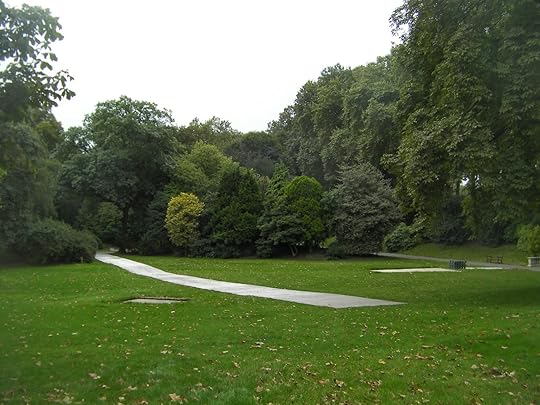
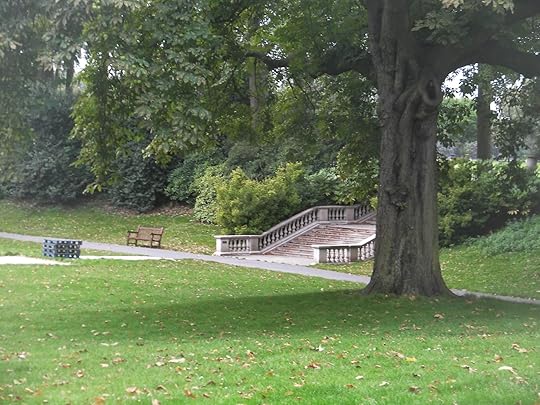
And then I did make my way to the Museum, where I was met with several oversized paintings of the Duke of Wellington. Welcome, indeed! No Chelsea Pensioners Reading the Waterloo Despatch to be seen, however. They must have it hanging in the Museum, I thought, but failed to find it as I made my through the exhibits.
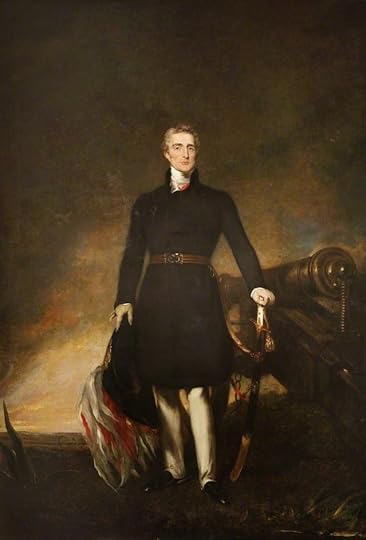
In the gift shop, I bought a Christmas ornament to add to my collection and then I asked how to find the Great Hall, where Wellington’s body had lay in state. Surely the painting of the Chelsea Pensioners had to be there. Following the directions I’d been given, I was making my way over to the Great Hall when I began to feel great discomfort at the top of each heel. You know, where your Achilles tendon is? I sat on a bench and took off one ballet flat – the back of the shoes were rubbing at the top of each heel and taking some skin off with each step. Believe me, I packed these flats because they’ve always been extremely comfortable. As were the sandals I’d worn on the way over. Until this particular trip.
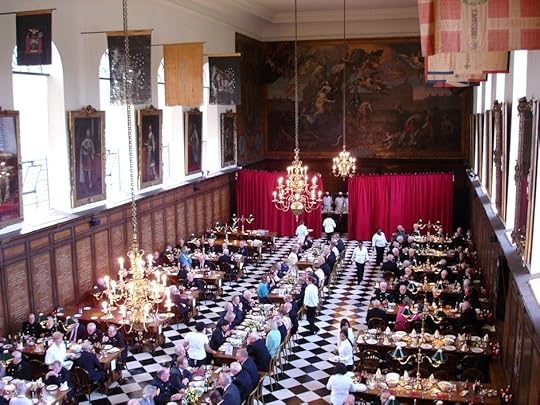
I finally found the Great Hall, only to discover that it was being used as a dining hall, set up with rows of long tables and chairs. It seemed much smaller than I’d imagined and try as I might, I couldn’t summon up the atmosphere that must have existed when thousands of people had streamed through to pay their final respects to the Duke of Wellington.
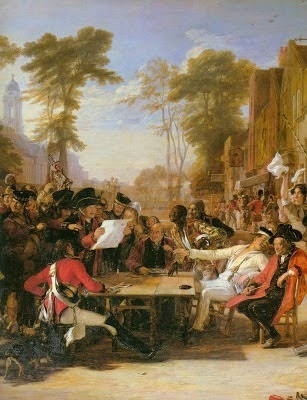
So back I limped to the gift shop, where I asked the nice old soldier behind the counter, “Do you know where The Chelsea Pensioner’s Reading the Waterloo Despatch is?”
“Pardon?”
“The painting, The Chelsea Pensioner’s Reading the Waterloo Despatch?”
“Pardon?”
“It’s a painting that was commissioned by the Duke of Wellington. Of ChelseaPensioners. Reading the Despatch. From Waterloo. About the victory? At Waterloo?”
“Never heard of it. Hey, Bert, have you ever heard of a painting called the Pensioners Reading . . . . what was it they were reading?”
“The Waterloo Despatch,” I told him.
“The Waterloo Despatch,” he told Bert.
“No,” said Bert, “Never heard of it. Maybe it’s in the Museum.”
“No, I’ve looked in the Museum and in the Great Hall,” I told them.
“Maybe it’s hanging in that little hallway out back,” Bert suggested.
“I’d think it would be hanging in the lobby,” I said, “Along with the other Wellingtonportraits. It would be closer to that size. It’s not a small thing.”
“Nope, don’t know anything about it,” said the first Pensioner. “I’ll take you along to the Administrator’s office. Mebbe they know where it’s at.” I followed him through a warren of hallways until we arrived at the Administrator’s Office.
“This lady’s looking fer a painting by the Duke of Wellington.”
I popped my head around the Pensioner and saw an assistant sitting behind her desk. “It was commissioned by the Duke of Wellington. The Chelsea Pensioner’s Reading the Waterloo Despatch?”
“I’m sorry?”
“It’s a painting depicting the red coated Pensioners sitting round a table reading the news of the victory at the Battle of Waterloo.”
“I’m not familiar with it, but all of our Wellington portraits are in the entrance hall. Have you looked there?”
“I have. It’s not there.”
“Well, I’ll tell you what, I’ll ask our curator when he comes in this week and I’ll try to find out where it is. Can you come back next week? Hopefully I’ll have an answer for you then.”
Well, there was nothing for it. I thanked her, and the Pensioner, and said I’d check back in a few weeks time, when I was due to return to London. Then I began the painful trek back to Sloane Square, for the second time. Whilst wearing a second pair of painful shoes that made every step I took sheer torture. Sigh.
Returning at last, again, in the hotel lobby, I again asked for Big Red to be brought out of the luggage holding area. I again applied bandages to my feet, this time to the backs of my heels and then I pulled on a pair of socks followed by a pair of flat boots with the fur trim. Yeah, I was aware that the temperatures were in the 70’s, but I was getting desperate. I was quickly running out of shoe options and my day was flying by. I still wanted to make my way over to Piccadilly and Apsley House. Footwear be damned – I headed out again, this time making my way to the tube station.
Part Two Coming Soon!
Published on October 27, 2014 00:00
October 24, 2014
TRAVELS WITH VICTORIA: THE BAYEUX TAPESTRY
On my recent trip to France, I fulfilled a lifelong desire to see the Bayeux Tapestry, that iconic portrayal of the Norman version of William I's invasion and conquest of Britain in 1066.
 Home of the Bayeux Tapestry We were on a Viking River cruise on the Seine, starting and finishing in Paris. One day was devoted to a bus trip from the river to the D-Day Normandy Landing Beaches. On the way, we stopped in the charming town of Bayeux to see the tapestry.
Home of the Bayeux Tapestry We were on a Viking River cruise on the Seine, starting and finishing in Paris. One day was devoted to a bus trip from the river to the D-Day Normandy Landing Beaches. On the way, we stopped in the charming town of Bayeux to see the tapestry.
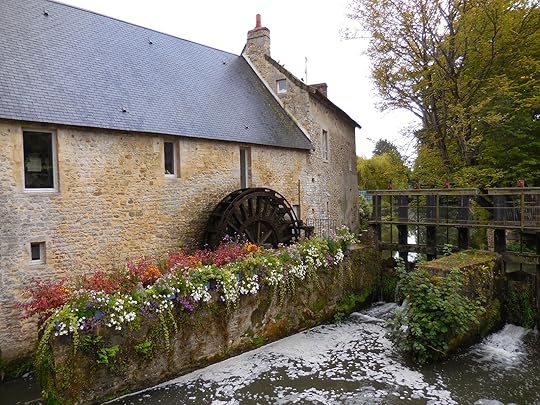 An old mill, on the path from the car park to the museum The tapestry is really woolen embroidery on linen, not a woven piece. Just who made it and when is a mystery, though the tale it tells -- the Norman side of the story -- indicates it was created by the women of the Norman court in England a few years after the Conquest. The controversy about its origins and the validity of its version of the Conquest remain contentious even today.
An old mill, on the path from the car park to the museum The tapestry is really woolen embroidery on linen, not a woven piece. Just who made it and when is a mystery, though the tale it tells -- the Norman side of the story -- indicates it was created by the women of the Norman court in England a few years after the Conquest. The controversy about its origins and the validity of its version of the Conquest remain contentious even today.
 Odo, Bishop of Bayeux, in the Battle of Hastings(pic from Wikipedia) To see the entire tapestry, click here.
Odo, Bishop of Bayeux, in the Battle of Hastings(pic from Wikipedia) To see the entire tapestry, click here.
Two-hundred thirty feet in length, the Bayeux Tapestry was created to be shown in cathedrals and large churches to tell the story and justify the Norman Conquest. In fifty scenes, the story of King Edward's (the Confessor, c.1003-1066) succession, the relationship of Harold, King of Wessex, and William Duke of Normandy. According to this version of the story, Harold is sent by the ailing Edward to France in order to deliver news of the King's choice of successor to William, who will become King of England upon Edward's death.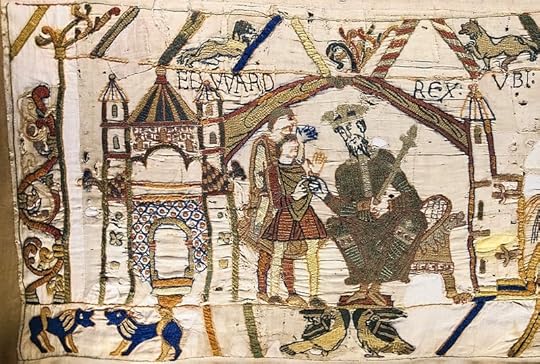 Edward gives Harold a message for William Even the guides at the museum in Bayeux agree this version is "propaganda" from the Norman side of the historical record. The actual wishes of Edward the Confessor might have been less important than the vote of the Witenagamot, an assembly of powerful nobles. The Witenagamot actually voted for Harold after the Confessor's death. But it is not necessary to view the Tapestry as the REAL story to admire it for its beauty and historical significance.
Edward gives Harold a message for William Even the guides at the museum in Bayeux agree this version is "propaganda" from the Norman side of the historical record. The actual wishes of Edward the Confessor might have been less important than the vote of the Witenagamot, an assembly of powerful nobles. The Witenagamot actually voted for Harold after the Confessor's death. But it is not necessary to view the Tapestry as the REAL story to admire it for its beauty and historical significance.
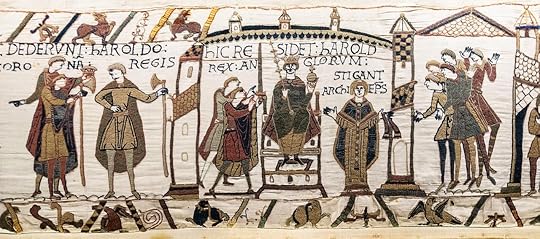 Harold's Coronation as King of England The tapestry was listed in the inventory of the Bayeux Cathedral in 1476; it was shown every year on the Feast of St. John the Baptist for centuries. Since being displayed in the Louvre, Paris, in 1797, it has been regarded as a national treasure.
Harold's Coronation as King of England The tapestry was listed in the inventory of the Bayeux Cathedral in 1476; it was shown every year on the Feast of St. John the Baptist for centuries. Since being displayed in the Louvre, Paris, in 1797, it has been regarded as a national treasure.
 scenes reproduced and for sale in the museum gift shop Numerous replicas exist and the scenes from the narrative had been studied as excellent sources of information about life in the 11th Century. The particular excellence of the stitching is praised and the colors are today quite brilliant for such an old creation.
scenes reproduced and for sale in the museum gift shop Numerous replicas exist and the scenes from the narrative had been studied as excellent sources of information about life in the 11th Century. The particular excellence of the stitching is praised and the colors are today quite brilliant for such an old creation.
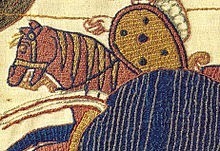 stitching details In horizontal sections at the top and bottom of the tapestry, scenes of everyday life are portrayed, events of the day told, and animals depicted.
stitching details In horizontal sections at the top and bottom of the tapestry, scenes of everyday life are portrayed, events of the day told, and animals depicted.
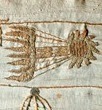 a comet The Bayeux Tapestry has survived many wars and planned confiscation by Napoleon and the Nazis, among others. One hand-stitched replica was used in the filming of the recent movie The Monuments Men (2014). The original is now shown beautifully in its own
Musée de la Tapisserie de Bayeux
.
a comet The Bayeux Tapestry has survived many wars and planned confiscation by Napoleon and the Nazis, among others. One hand-stitched replica was used in the filming of the recent movie The Monuments Men (2014). The original is now shown beautifully in its own
Musée de la Tapisserie de Bayeux
.
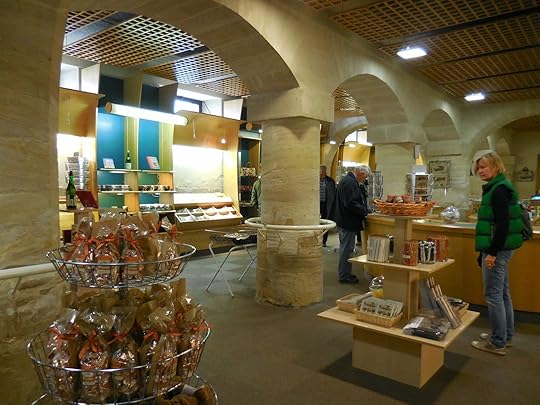 Museum Giftshop A few years ago, I visited the site of the Battle of Hastings in Sussex where an audio tour leads one around the grounds, told in the voices of the women who were attached to the two leaders, Harold and William.
Museum Giftshop A few years ago, I visited the site of the Battle of Hastings in Sussex where an audio tour leads one around the grounds, told in the voices of the women who were attached to the two leaders, Harold and William.
 Site of the Battle of Hastings, 1066 Here, on the site of the death of Harold, William erected an Abbey, now partly in ruins and partly school.
Site of the Battle of Hastings, 1066 Here, on the site of the death of Harold, William erected an Abbey, now partly in ruins and partly school.
 Death of Harold, Bayeux Tapestry
Death of Harold, Bayeux Tapestry
 Site of the High Altar, said to be where Harold fell As we walked around the ruins on that October day, we noticed flowers on the site of the High Altar. We when looked closely, we got chills! Here was a tribute, almost thousand years later.
Site of the High Altar, said to be where Harold fell As we walked around the ruins on that October day, we noticed flowers on the site of the High Altar. We when looked closely, we got chills! Here was a tribute, almost thousand years later.
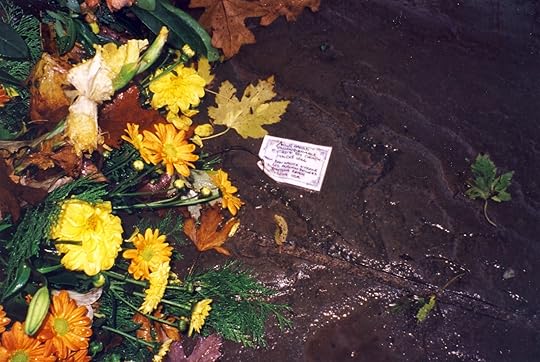 It reads: "King Harold: Unconquerable Except by Death, 14 Oct, 1066"
It reads: "King Harold: Unconquerable Except by Death, 14 Oct, 1066"
 Pub Sign in Battle, Sussex Of course, the pub owner could not resist!! We settled in, actually for a pot of tea, after our encounter with the Abbey, the battle and the flowers left by admirer from centuries after the fighting. Battle, the spot where the conflict took place and the town named so cleverly, is a few miles inland from Hastings, where the Norman fleet landed on the coast.
Pub Sign in Battle, Sussex Of course, the pub owner could not resist!! We settled in, actually for a pot of tea, after our encounter with the Abbey, the battle and the flowers left by admirer from centuries after the fighting. Battle, the spot where the conflict took place and the town named so cleverly, is a few miles inland from Hastings, where the Norman fleet landed on the coast.
 Bayeux Cathedral Returning to my trip of 2014, we left the Tapestry to go to the Bayeux Commonwealth War Graves Commission Cemetery, where more than 4,600 are buried. A marble memorial stands at the entrance.
Bayeux Cathedral Returning to my trip of 2014, we left the Tapestry to go to the Bayeux Commonwealth War Graves Commission Cemetery, where more than 4,600 are buried. A marble memorial stands at the entrance.
 The Inscription reads (in Latin) "We, once conquered by William, have now set free the Conqueror's native land." Chills once more!! To conclude the day, we toured the Normandy American Cemetery and Omaha Beach, accompanied by many more chills of appreciation.
The Inscription reads (in Latin) "We, once conquered by William, have now set free the Conqueror's native land." Chills once more!! To conclude the day, we toured the Normandy American Cemetery and Omaha Beach, accompanied by many more chills of appreciation.
 The Memorial at the American Cemetery
The Memorial at the American Cemetery
 Among the 9,400 graves
Among the 9,400 graves
 Omaha Beach
Omaha Beach
 Les Braves, memorial sculpture by Anilore Banonin honor of the 60th anniversary of D-Day, 2004
Les Braves, memorial sculpture by Anilore Banonin honor of the 60th anniversary of D-Day, 2004

 Home of the Bayeux Tapestry We were on a Viking River cruise on the Seine, starting and finishing in Paris. One day was devoted to a bus trip from the river to the D-Day Normandy Landing Beaches. On the way, we stopped in the charming town of Bayeux to see the tapestry.
Home of the Bayeux Tapestry We were on a Viking River cruise on the Seine, starting and finishing in Paris. One day was devoted to a bus trip from the river to the D-Day Normandy Landing Beaches. On the way, we stopped in the charming town of Bayeux to see the tapestry.
 An old mill, on the path from the car park to the museum The tapestry is really woolen embroidery on linen, not a woven piece. Just who made it and when is a mystery, though the tale it tells -- the Norman side of the story -- indicates it was created by the women of the Norman court in England a few years after the Conquest. The controversy about its origins and the validity of its version of the Conquest remain contentious even today.
An old mill, on the path from the car park to the museum The tapestry is really woolen embroidery on linen, not a woven piece. Just who made it and when is a mystery, though the tale it tells -- the Norman side of the story -- indicates it was created by the women of the Norman court in England a few years after the Conquest. The controversy about its origins and the validity of its version of the Conquest remain contentious even today.
 Odo, Bishop of Bayeux, in the Battle of Hastings(pic from Wikipedia) To see the entire tapestry, click here.
Odo, Bishop of Bayeux, in the Battle of Hastings(pic from Wikipedia) To see the entire tapestry, click here. Two-hundred thirty feet in length, the Bayeux Tapestry was created to be shown in cathedrals and large churches to tell the story and justify the Norman Conquest. In fifty scenes, the story of King Edward's (the Confessor, c.1003-1066) succession, the relationship of Harold, King of Wessex, and William Duke of Normandy. According to this version of the story, Harold is sent by the ailing Edward to France in order to deliver news of the King's choice of successor to William, who will become King of England upon Edward's death.
 Edward gives Harold a message for William Even the guides at the museum in Bayeux agree this version is "propaganda" from the Norman side of the historical record. The actual wishes of Edward the Confessor might have been less important than the vote of the Witenagamot, an assembly of powerful nobles. The Witenagamot actually voted for Harold after the Confessor's death. But it is not necessary to view the Tapestry as the REAL story to admire it for its beauty and historical significance.
Edward gives Harold a message for William Even the guides at the museum in Bayeux agree this version is "propaganda" from the Norman side of the historical record. The actual wishes of Edward the Confessor might have been less important than the vote of the Witenagamot, an assembly of powerful nobles. The Witenagamot actually voted for Harold after the Confessor's death. But it is not necessary to view the Tapestry as the REAL story to admire it for its beauty and historical significance.
 Harold's Coronation as King of England The tapestry was listed in the inventory of the Bayeux Cathedral in 1476; it was shown every year on the Feast of St. John the Baptist for centuries. Since being displayed in the Louvre, Paris, in 1797, it has been regarded as a national treasure.
Harold's Coronation as King of England The tapestry was listed in the inventory of the Bayeux Cathedral in 1476; it was shown every year on the Feast of St. John the Baptist for centuries. Since being displayed in the Louvre, Paris, in 1797, it has been regarded as a national treasure.
 scenes reproduced and for sale in the museum gift shop Numerous replicas exist and the scenes from the narrative had been studied as excellent sources of information about life in the 11th Century. The particular excellence of the stitching is praised and the colors are today quite brilliant for such an old creation.
scenes reproduced and for sale in the museum gift shop Numerous replicas exist and the scenes from the narrative had been studied as excellent sources of information about life in the 11th Century. The particular excellence of the stitching is praised and the colors are today quite brilliant for such an old creation.
 stitching details In horizontal sections at the top and bottom of the tapestry, scenes of everyday life are portrayed, events of the day told, and animals depicted.
stitching details In horizontal sections at the top and bottom of the tapestry, scenes of everyday life are portrayed, events of the day told, and animals depicted.
 a comet The Bayeux Tapestry has survived many wars and planned confiscation by Napoleon and the Nazis, among others. One hand-stitched replica was used in the filming of the recent movie The Monuments Men (2014). The original is now shown beautifully in its own
Musée de la Tapisserie de Bayeux
.
a comet The Bayeux Tapestry has survived many wars and planned confiscation by Napoleon and the Nazis, among others. One hand-stitched replica was used in the filming of the recent movie The Monuments Men (2014). The original is now shown beautifully in its own
Musée de la Tapisserie de Bayeux
.
 Museum Giftshop A few years ago, I visited the site of the Battle of Hastings in Sussex where an audio tour leads one around the grounds, told in the voices of the women who were attached to the two leaders, Harold and William.
Museum Giftshop A few years ago, I visited the site of the Battle of Hastings in Sussex where an audio tour leads one around the grounds, told in the voices of the women who were attached to the two leaders, Harold and William.
 Site of the Battle of Hastings, 1066 Here, on the site of the death of Harold, William erected an Abbey, now partly in ruins and partly school.
Site of the Battle of Hastings, 1066 Here, on the site of the death of Harold, William erected an Abbey, now partly in ruins and partly school.
 Death of Harold, Bayeux Tapestry
Death of Harold, Bayeux Tapestry
 Site of the High Altar, said to be where Harold fell As we walked around the ruins on that October day, we noticed flowers on the site of the High Altar. We when looked closely, we got chills! Here was a tribute, almost thousand years later.
Site of the High Altar, said to be where Harold fell As we walked around the ruins on that October day, we noticed flowers on the site of the High Altar. We when looked closely, we got chills! Here was a tribute, almost thousand years later.
 It reads: "King Harold: Unconquerable Except by Death, 14 Oct, 1066"
It reads: "King Harold: Unconquerable Except by Death, 14 Oct, 1066"
 Pub Sign in Battle, Sussex Of course, the pub owner could not resist!! We settled in, actually for a pot of tea, after our encounter with the Abbey, the battle and the flowers left by admirer from centuries after the fighting. Battle, the spot where the conflict took place and the town named so cleverly, is a few miles inland from Hastings, where the Norman fleet landed on the coast.
Pub Sign in Battle, Sussex Of course, the pub owner could not resist!! We settled in, actually for a pot of tea, after our encounter with the Abbey, the battle and the flowers left by admirer from centuries after the fighting. Battle, the spot where the conflict took place and the town named so cleverly, is a few miles inland from Hastings, where the Norman fleet landed on the coast.
 Bayeux Cathedral Returning to my trip of 2014, we left the Tapestry to go to the Bayeux Commonwealth War Graves Commission Cemetery, where more than 4,600 are buried. A marble memorial stands at the entrance.
Bayeux Cathedral Returning to my trip of 2014, we left the Tapestry to go to the Bayeux Commonwealth War Graves Commission Cemetery, where more than 4,600 are buried. A marble memorial stands at the entrance.
 The Inscription reads (in Latin) "We, once conquered by William, have now set free the Conqueror's native land." Chills once more!! To conclude the day, we toured the Normandy American Cemetery and Omaha Beach, accompanied by many more chills of appreciation.
The Inscription reads (in Latin) "We, once conquered by William, have now set free the Conqueror's native land." Chills once more!! To conclude the day, we toured the Normandy American Cemetery and Omaha Beach, accompanied by many more chills of appreciation.
 The Memorial at the American Cemetery
The Memorial at the American Cemetery Among the 9,400 graves
Among the 9,400 graves Omaha Beach
Omaha Beach
 Les Braves, memorial sculpture by Anilore Banonin honor of the 60th anniversary of D-Day, 2004
Les Braves, memorial sculpture by Anilore Banonin honor of the 60th anniversary of D-Day, 2004

Published on October 24, 2014 00:30
October 21, 2014
VIDEO WEDNESDAY: TOUR OF THE OLD CORONATION STREET SET

As some of you may recall, when Victoria and I were first planning the Duke of Wellington Tour, I was anxious to schedule a side trip to the old Granada Studios in Manchester to see the set of Coronation Street. The entire production has since moved to a new set at a larger facility, where every house, every cobble and every shop has been faithfully recreated. The old set is now open for daily tours and I so wanted to get there in order to see it all before it was dismantled. Unfortunately, a side trip to the north of England was not in the cards this trip over. However, I did find an amateur video that a fan (stunninglad1) kindly recorded during their trip to the cobbles and you can watch it here. The video includes an overview of the street, a look at the individual houses, all the shops, Rosamund Street, the bus stop and even the ginnel! Night falls towards the end of the half hour video and you can see the lights come on as night falls over this beloved section of Weatherfield. A true trip down memory lane that we hope you'll enjoy.
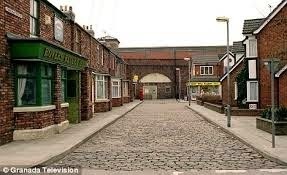
Published on October 21, 2014 23:30
October 20, 2014
LOOSE IN LONDON: KRISTINE LEAVES FOR HEATHROW - PART THREE
I turned away from the United desk and began the journey up the escalator to the security checkpoint whilst carrying the incredibly heavy black bag, with the incredibly heavy purse now slung like a cross-body around my torso. My little toes screamed with every step and I silently screamed back.

"Just a bit longer," I told myself, "and you'll be in England for nearly a month. A month. You can do this!" Of course, there were many more passengers waiting to go through security than there were security check points to deal with them efficiently. The line crawled along and I inched my way towards the scanners one painful step at a time. Who knew that my most comfortable sandals would turn into devices of torture simply because I'd been forced to carry an extra forty pounds or so?
Finally, I made it through security and retrieved my belongings from the conveyor belt before I scanned the signs overhead to see where my gate was. The sign read "Gates 1 to 2,034 to the Right."
I wanted to cry. My gate was literally the last one. The absolute furthest from where I now stood.
I longed to remove my shoes, but thought better of that - no telling what was embedded in the floors after millions of passengers had trod on them. I thought about having a drink, but didn't see any bars. Finally, I thought about the men who had comprised Wellington's armies and how far they'd been asked to walk on a daily basis. Surely 19th century boots had to have been more uncomfortable than my sandals after walking miles in them whilst carrying heavy packs on their backs, along with weapons and ammunition. And canteens. All whilst wearing red woolen coats. In the heat of the Peninsula. Or in India. At least at the end of my journey I'd be at the plane that would be flying me to England. A much better destination than a battle at Waterloo, surely.
"Just a bit longer," I told myself, "and you'll be in England for nearly a month. A month. You can do this!"
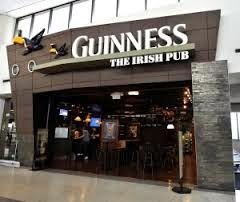
The longer I walked, the more painful each step became. Before long, I was limping along like an old lady. A really old lady. And I still hadn't passed a single bar. Finally, I spotted a maintenance worker by a trash can and asked him, "Where's the nearest place I can get a drink?"
"Huh?"
"A drink. Liquor. A cocktail. You know, a bar?"
"Oh, right. Well, there's an Irish pub down that way, right across the way from Gate 2,034."
Thinking that there may just be a God after all, I slowly completed the last painful mile that separated me from the nearest bottle of Bacardi.
Arriving at last at Mecca, I sat down at the bar and ordered a double rum and coke and a tall glass of water, which I finished half of in a few gulps as soon as it arrived. The water, not the rum and coke. Then I called Hubby to let him know I'd arrived in Newark and allowed him a couple of I told you so's in regards to my present problem regarding overweight luggage. When we'd hung up, I spotted a redhead climbing onto the stool beside mine. The bartender came over and she ordered herself a white wine. We both sat sipping at our drinks for a few minutes before she asked me if I were going to Dusseldorf.
"No. London," I said curtly, not being in the mood for casual chit chat. I picked up my glass of water and finished it off in another few gulps.
"You shouldn't drink water, you know. It'll poison you. Our kidneys can't process all the poisons in water. My kidneys haven't worked for fourteen years."
Oh, great. A health nut.
"I only drink wine. White wine. The red stuff has too many chemicals in it. It'll kill you."
Sigh.
"I always drink wine, whether I'm at home or traveling. I'm going to Dusseldorf for the weekend,"
Against my better judgement, I said, "You're flying all the way to Dusseldorf just for the weekend?"
"Yeah. I fly to Europe for the weekend once or twice a month. I've been everywhere. I've been doing it for years."
"How do you manage that, I mean with the dialysis and that."
"What dialysis?"
"You said that your kidneys hadn't worked in fourteen years,"
"Oh, that. No, I'm not dialysis. I still have my kidneys, they just don't work. They haven't worked since I fell into a canal in Venice."
I finished off my rum and coke and ordered another.
"See, the water in the canals is filthy, just filthy. And when I fell in, I was attacked by this type of parasite that lives in the water there. The parasites invaded my body and attacked my organs and my kidneys and they shut down and haven't worked right since. Water will kill you, believe me."
Oh, great. Not a health nut. Just your average, garden variety nutter. No way was I going to ask her how she'd managed to fall into a canal in the first place.
"I believe you. That's why I only drink rum," I said instead as I slid my credit card across the bar towards the bartender. While I was waiting for my receipt, I fished around in my purse for my sleeping pills, shook a couple out into my hand and downed them with a swallow of rum and coke. I had an hour until my flight boarded and, with any luck, I'd be nice and drowsy by the time we lifted off.
Limping my way across to my departure gate I told myself, "Just a bit longer and you'll be in England for nearly a month. A month. You can do this!"
Published on October 20, 2014 00:00
October 17, 2014
MONTREAL'S MEETING OF THE JANE AUSTEN SOCIETY OF NORTH AMERICA

Victoria here, just back from the excellent Annual General Meeting of the Jane Austen Society of North America in Montreal, Quebec, Canada. The days were packed with all sorts of events -- many presentations on Mansfield Park's characters, events, and background, plus workshops, dancing lessons, teas and banquets, tours, performances, and of course, shopping.
 Elaine Bander, chair of the 2014 Steering Committee, opens the AGM 2014 is the 200th anniversary of the publication of Mansfield Park, Jane Austen's first novel begun and completed after she came to live at Chawton Cottage. Also published in 2014 was Frances Burney's fourth novel, The Wanderer.
Elaine Bander, chair of the 2014 Steering Committee, opens the AGM 2014 is the 200th anniversary of the publication of Mansfield Park, Jane Austen's first novel begun and completed after she came to live at Chawton Cottage. Also published in 2014 was Frances Burney's fourth novel, The Wanderer.
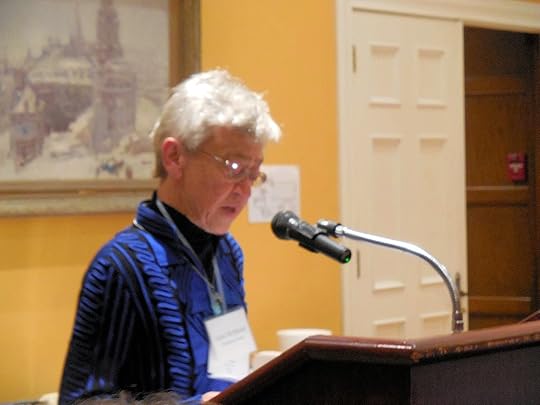 Juliet McMaster Before the AGM began, Juliet McMaster addressed a joint tea for members of the Frances Burney Society and JASNA on "Female Difficulties: Austen's Fanny (of Mansfield Park) and Burney's Juliet (of The Wanderer)." (I apologize for the slightly blurry pics sometimes). I will report further on the meeting of the Burney Society in a future post.
Juliet McMaster Before the AGM began, Juliet McMaster addressed a joint tea for members of the Frances Burney Society and JASNA on "Female Difficulties: Austen's Fanny (of Mansfield Park) and Burney's Juliet (of The Wanderer)." (I apologize for the slightly blurry pics sometimes). I will report further on the meeting of the Burney Society in a future post. Montreal's Autumn Tints Montreal was sunny and ranged from chilly to warm most days. Since it was my first visit, I tried to see as much as I could, but found myself in almost every JASNA session I could manage. The plenary speakers were all excellent, and I attended many outstanding Break-Out Sessions.
Montreal's Autumn Tints Montreal was sunny and ranged from chilly to warm most days. Since it was my first visit, I tried to see as much as I could, but found myself in almost every JASNA session I could manage. The plenary speakers were all excellent, and I attended many outstanding Break-Out Sessions.
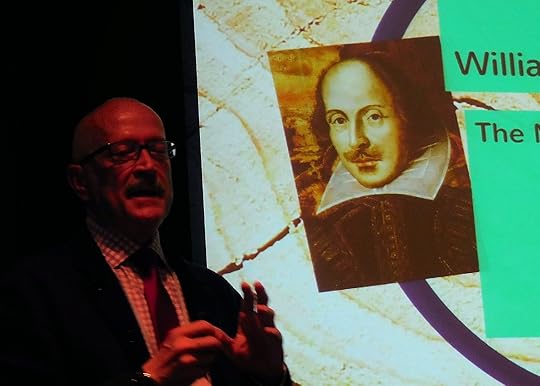 Chicago's Russell Clark on "Plays Passed Over in MP"
Chicago's Russell Clark on "Plays Passed Over in MP"
 Sarah Parry of Chawton House Library spoke on the houses in MP and what they tell us about their inhabitants. Goucher College is planning to digitize a rare copy of the first American edition of Jane Austen's Emma printed in Philadephia in 1816.
Sarah Parry of Chawton House Library spoke on the houses in MP and what they tell us about their inhabitants. Goucher College is planning to digitize a rare copy of the first American edition of Jane Austen's Emma printed in Philadephia in 1816.
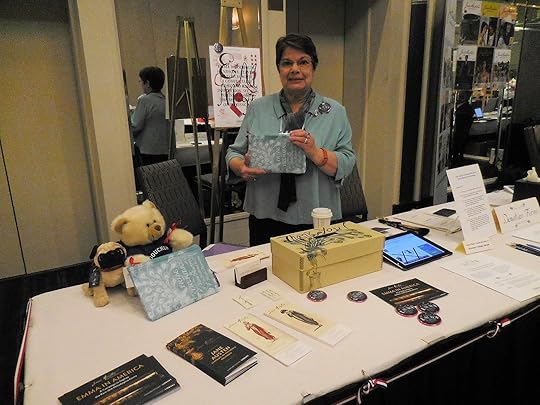 Looking for contributions to the Emma Campaign
Looking for contributions to the Emma Campaign
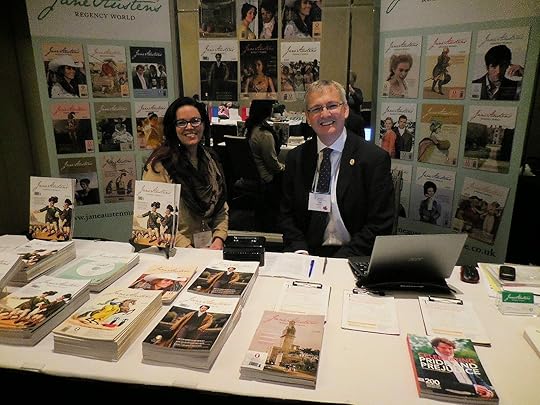 Tim Bullamore (r), publisher of Jane Austen's Regency World Magazine
Tim Bullamore (r), publisher of Jane Austen's Regency World Magazine
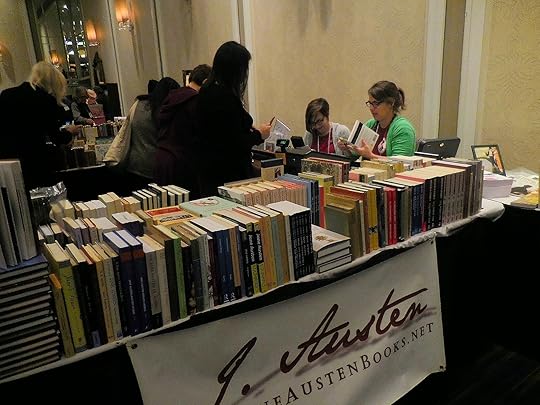 Jane Austen Books doing a brisk business
Jane Austen Books doing a brisk business
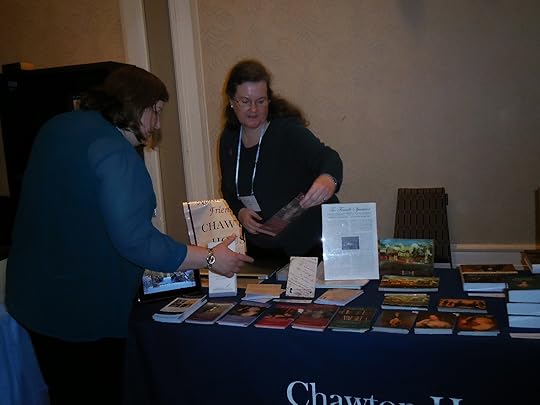 Sarah Parry at the Chawton House Library table Among the other speakers I enjoyed were Robert Clark on "Jane Austen and the Moral British Empire," Kathryn Davis on "Charles Pasley's Essays" (known to be favorites of Austen), Janine Barchas on "Reading Mansfield Park with Nabokov," and Jocelyn Harris on "Fanny Burney and Fanny Price." No pictures, even blurry ones, turned out. And of course there were dozens of talks I could not attend but which I long to hear in the future -- or read in Persuasions in print or on-line. I also failed to get pictures of the clever version of Lover's Vows, written and produced by Diana Birchall and Syrie James, entitled "A Dangerous Intimacy: Behind the Scenes at Mansfield Park."
Sarah Parry at the Chawton House Library table Among the other speakers I enjoyed were Robert Clark on "Jane Austen and the Moral British Empire," Kathryn Davis on "Charles Pasley's Essays" (known to be favorites of Austen), Janine Barchas on "Reading Mansfield Park with Nabokov," and Jocelyn Harris on "Fanny Burney and Fanny Price." No pictures, even blurry ones, turned out. And of course there were dozens of talks I could not attend but which I long to hear in the future -- or read in Persuasions in print or on-line. I also failed to get pictures of the clever version of Lover's Vows, written and produced by Diana Birchall and Syrie James, entitled "A Dangerous Intimacy: Behind the Scenes at Mansfield Park."
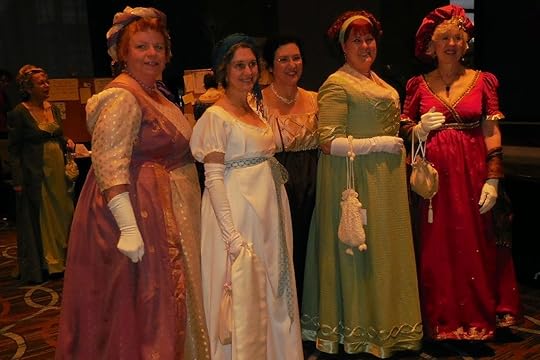 Ladies at the Ball
Ladies at the Ball
 Ken and Elaine Weeks of Seattle
Ken and Elaine Weeks of Seattle
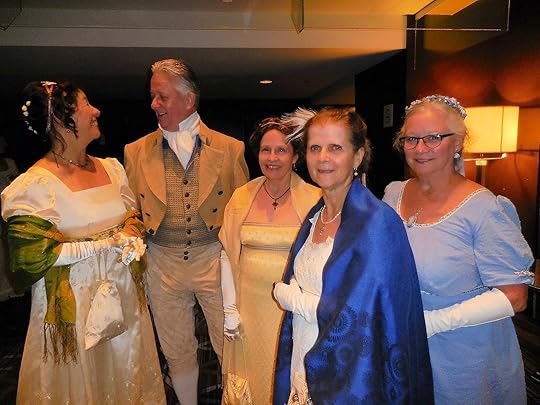 More ball participants
More ball participants
 Jerry Vetowich and Nili Olay
Jerry Vetowich and Nili Olay
 Kim Wilson and Sue Forgue During the Ball, Kim and I provided the comic relief with our talk on "Gilpin, the Picturesque, and Dr. Syntax." I'll report more on our talk at a later date.
Kim Wilson and Sue Forgue During the Ball, Kim and I provided the comic relief with our talk on "Gilpin, the Picturesque, and Dr. Syntax." I'll report more on our talk at a later date.
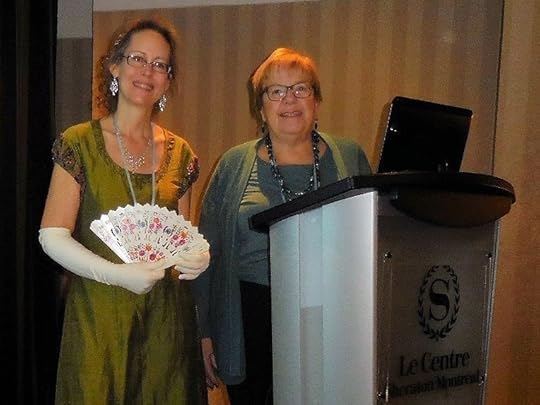 Kim Wilson, whose latest book is Jane Austen At Home, and Victoria Hinshaw
Kim Wilson, whose latest book is Jane Austen At Home, and Victoria Hinshaw
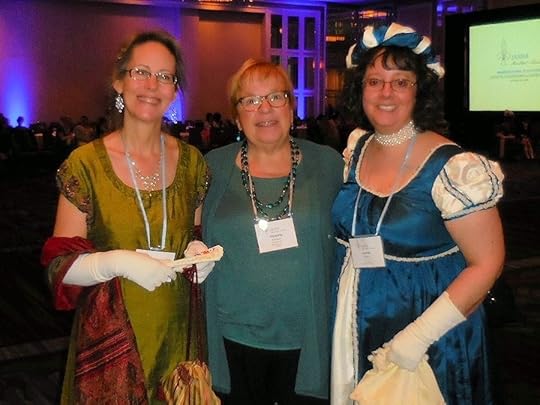 Authors and pals: Kim, Vicky and Carrie Bebris, who writes the Mr. and Mrs. Darcy Mystery Series Sunday morning, the AGM closed with a wonderful brunch and a terrific speaker, Patrick Stokes, chair of the Jane Austen Society (UK) from 2004-2009. His topic, "Rears and Vices: The Georgian Royal Navy in Mansfield Park," was full of enlightening information and many laughs. He wore the uniform of a rear admiral in 1814.
Authors and pals: Kim, Vicky and Carrie Bebris, who writes the Mr. and Mrs. Darcy Mystery Series Sunday morning, the AGM closed with a wonderful brunch and a terrific speaker, Patrick Stokes, chair of the Jane Austen Society (UK) from 2004-2009. His topic, "Rears and Vices: The Georgian Royal Navy in Mansfield Park," was full of enlightening information and many laughs. He wore the uniform of a rear admiral in 1814.
 Patrick Stokes, gggrandson of Admiral Charles Austen (1779-1852),Jane Austen's youngest brother
Patrick Stokes, gggrandson of Admiral Charles Austen (1779-1852),Jane Austen's youngest brother
 Patrick Stokes and Victoria Hinshaw After the brunch conclude Mr. Stokes was kind enough to pose for many pictures with audience members, as he exhibited the replica he made of Jane Austen's writing desk.
Patrick Stokes and Victoria Hinshaw After the brunch conclude Mr. Stokes was kind enough to pose for many pictures with audience members, as he exhibited the replica he made of Jane Austen's writing desk.
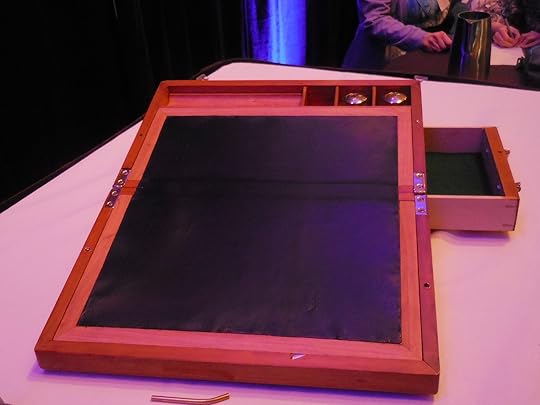 Replica of Jane Austen's writing desk
Replica of Jane Austen's writing desk
 Presidents of JASNA: Joan Ray, Marsha Huff, Iris Lutz, and incoming president Claire Bellanti
Presidents of JASNA: Joan Ray, Marsha Huff, Iris Lutz, and incoming president Claire Bellanti
 Joan Ray, Iris Lutz, Lorraine Hanaway, and Clair Bellanti Thanks to Elaine Bander, the Steering Committee, and all the volunteers for a wonderful AGM. Next year, JASNA will meet in Louisville, KY, October 9-11, 2015, "Living in Jane Austen's World."
Joan Ray, Iris Lutz, Lorraine Hanaway, and Clair Bellanti Thanks to Elaine Bander, the Steering Committee, and all the volunteers for a wonderful AGM. Next year, JASNA will meet in Louisville, KY, October 9-11, 2015, "Living in Jane Austen's World."
Published on October 17, 2014 00:30
October 15, 2014
REMEMBERING AUTHOR DIANA NORMAN
By Guest Blogger Jo Manning
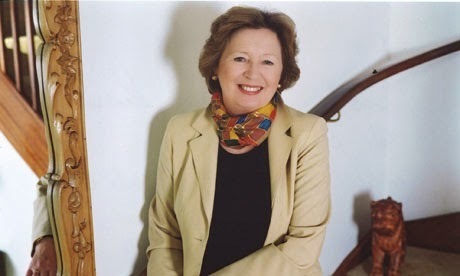
“I stagger towards the last line of a book like a drunk navigating furniture,” said Diana Norman. Photograph: Mary Jane Russell
The historical fiction author Diana Norman was a veritable giant of the genre. Arguably, the best amongst many. Her history was impeccable, and she never shortchanged those readers, letting them know when she had to make things up for the purpose her plots. Her characters are remarkable, fully-fleshed-out human beings who are sympathetic and memorable, and her stories are romantic and compelling. She wrote books that were extremely difficult to put aside.
Although I first came to know her work upon the publication of her last series of books – Mistress Of The Art Of Death was the first one -- those featuring the 12th-century Sicilian pathologist/medical examiner Adelia Aguilar, which the obituary in The Guardian opens with, I must disagree with the reporter’s assertion that Norman “was best known” for these books. Those of us who love novels set during the English Restoration and Regency periods would beg to differ. (And I have my colleague Margaret Evans Porter to thank for introducing those to me.)
The Vizard Mask , set during the Restoration, when the son of the murdered King Charles I, Charles II, was put on the throne, restoring the Stuart monarchy interrupted by the Cromwell interregnum, is a masterpiece. And it is a hefty piece of work, indeed; I thought it, however, too short, because the writing was so brilliant. Norman explored Restoration theatre – and the growing role of women on the stage – the harrowing Plague and its deadly consequences – the byzantine world of 17th century politics – and the Puritan/Roman Catholic conflict that was to continue on for many years after the death of Charles II.
Norman enriches her stories by mixing in many historic and literary personages along with her fictional characters. The Shores Of Darkness has a wonderfully funny profile of the always-in-debt/always-in-trouble-with-the-authorities pamphleteer and author Daniel De Foe (a recurring joke being those who are constantly corrected by the self-important Mr Foe to insert the “De” before what others think is his full surname). The Vizard Mask introduced me to an important and complex historical personage and military man, Prince Rupert of the Rhine, nephew of Charles I and brother of the Electress Sophia of Hanover, whom I’d not previously encountered.
Her women are wonderful! Makepeace, the New England Puritan spinster/tavern owner (yes!) protagonist of A Catch Of Consequence is funny, good-hearted, and feisty. She captures the heart of an English aristocrat in this first book of her trilogy (the “catch” of the title), suffers mightily, wins, loses terribly, and finally triumphs to become a wealthy and fulfilled businesswoman, happy in her achievements and family and not brought down by widowhood and penury. The last of the trilogy is really her daughter’s story (the daughter she had with the handsome “catch”) who winds up in Paris during the Reign of Terror and is caught up in its ugliness and deaths. That book is called The Sparks Fly Upward ; the second of the trilogy – referred to as the Makepeace Hedley series – is Taking Liberties .
I did a good deal of research for the part of my biography of Grace Dalrymple Elliott, My Lady Scandalous , that had to do with the French Revolution and can attest to her good and careful research here. It is truly mesmerizing storytelling – and what intricate plotting! – both combined with meticulous factual information; Norman was a rare mistress of these arts that go into writing splendid historical fiction, much as her 12th-century character Adelia is a “mistress of the art of death”.
In all, she wrote some sixteen historical novels (four of them in the Adelia Aguilar series – and please note that titles were changed for publication in the United States) -- and three works of non-fiction, of which The Stately Ghosts Of England , a very short book published in 1963, is a fun read on her adventures in haunted houses.
Mary Diana Narracott, London-born, was taken to Devon to escape the Blitz. Hard to believe that she left school at the age of fifteen and went on to become such a fabulous writer. (But her father had been a journalist, so she came by her talent naturally!) She started out her career as a journalist, becoming probably the youngest reporter on Fleet Street. She married Barry Norman, a fellow journalist (he always said she was the better writer) – she wrote for the Daily Herald and he for the Daily Sketch -- and they had two daughters. Leaving Fleet Street for motherhood, she managed to squeeze in another career, that of local magistrate, whilst undertaking her newer challenge, the writing of fiction.
Barry Norman wrote a moving, loving tribute to Diana on her death that has been widely reprinted. You can read it here. Keep a tissue handy during your reading of it.
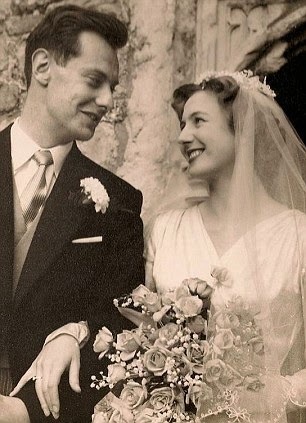 Diana and Barry on their wedding day in 1957 Barry Norman wrote: She was beautiful, witty, highly intelligent, quirky, stubborn and always immense fun to be with. She was a devoted wife, mother and grandmother and she was also — this is not just my opinion — one of the most gifted historical novelists around. I loved her to death and beyond.
Diana and Barry on their wedding day in 1957 Barry Norman wrote: She was beautiful, witty, highly intelligent, quirky, stubborn and always immense fun to be with. She was a devoted wife, mother and grandmother and she was also — this is not just my opinion — one of the most gifted historical novelists around. I loved her to death and beyond.
She appeared on the New York Times and other bestseller lists and received awards from the Crime Writers’ Association for titles in the last of her series, which were genuinely more historical crime thrillers than her historical novels – though a soupcon of mystery was always a delicious part of those novels as well.
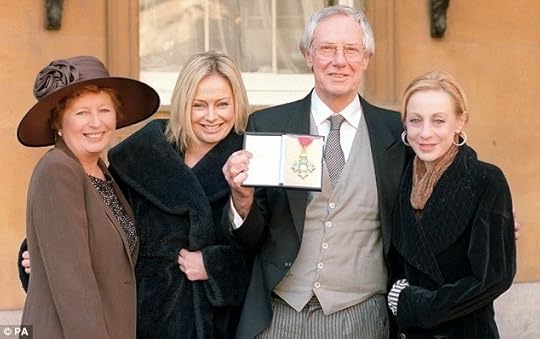 “Proud: Both Barry and Diana achieved acclaim in their chosen field, with Barry earning a CBE. They are pictured with daughters Samantha (left) and Emma (right)”
“Proud: Both Barry and Diana achieved acclaim in their chosen field, with Barry earning a CBE. They are pictured with daughters Samantha (left) and Emma (right)”
I love what she says about her writing her crime thrillers here and must end with this quote:
"The lovely thing about the 12th century is that you don't have to go too far to find wonderful plots. I always plot first. If you're writing thrillers which, of all the genres, have to be well-constructed and not streams of consciousness, you've got to know where you're going. I have the last line of the book in my head before I sit down to write and I stagger towards it like a drunk navigating furniture to get to the far side of the room."
She once cited some of her literary influences: Tolstoy; Dickens; Austen; Raymond Chandler; and John Le Carre. An eclectic mix…but, all, wonderful writers, as Diana Norman was. Do read her…you run the chance of becoming addicted, but I can hardly imagine a lovelier addiction than the novels of the brilliant Diana Norman.

“I stagger towards the last line of a book like a drunk navigating furniture,” said Diana Norman. Photograph: Mary Jane Russell
The historical fiction author Diana Norman was a veritable giant of the genre. Arguably, the best amongst many. Her history was impeccable, and she never shortchanged those readers, letting them know when she had to make things up for the purpose her plots. Her characters are remarkable, fully-fleshed-out human beings who are sympathetic and memorable, and her stories are romantic and compelling. She wrote books that were extremely difficult to put aside.
Although I first came to know her work upon the publication of her last series of books – Mistress Of The Art Of Death was the first one -- those featuring the 12th-century Sicilian pathologist/medical examiner Adelia Aguilar, which the obituary in The Guardian opens with, I must disagree with the reporter’s assertion that Norman “was best known” for these books. Those of us who love novels set during the English Restoration and Regency periods would beg to differ. (And I have my colleague Margaret Evans Porter to thank for introducing those to me.)
The Vizard Mask , set during the Restoration, when the son of the murdered King Charles I, Charles II, was put on the throne, restoring the Stuart monarchy interrupted by the Cromwell interregnum, is a masterpiece. And it is a hefty piece of work, indeed; I thought it, however, too short, because the writing was so brilliant. Norman explored Restoration theatre – and the growing role of women on the stage – the harrowing Plague and its deadly consequences – the byzantine world of 17th century politics – and the Puritan/Roman Catholic conflict that was to continue on for many years after the death of Charles II.
Norman enriches her stories by mixing in many historic and literary personages along with her fictional characters. The Shores Of Darkness has a wonderfully funny profile of the always-in-debt/always-in-trouble-with-the-authorities pamphleteer and author Daniel De Foe (a recurring joke being those who are constantly corrected by the self-important Mr Foe to insert the “De” before what others think is his full surname). The Vizard Mask introduced me to an important and complex historical personage and military man, Prince Rupert of the Rhine, nephew of Charles I and brother of the Electress Sophia of Hanover, whom I’d not previously encountered.
Her women are wonderful! Makepeace, the New England Puritan spinster/tavern owner (yes!) protagonist of A Catch Of Consequence is funny, good-hearted, and feisty. She captures the heart of an English aristocrat in this first book of her trilogy (the “catch” of the title), suffers mightily, wins, loses terribly, and finally triumphs to become a wealthy and fulfilled businesswoman, happy in her achievements and family and not brought down by widowhood and penury. The last of the trilogy is really her daughter’s story (the daughter she had with the handsome “catch”) who winds up in Paris during the Reign of Terror and is caught up in its ugliness and deaths. That book is called The Sparks Fly Upward ; the second of the trilogy – referred to as the Makepeace Hedley series – is Taking Liberties .
I did a good deal of research for the part of my biography of Grace Dalrymple Elliott, My Lady Scandalous , that had to do with the French Revolution and can attest to her good and careful research here. It is truly mesmerizing storytelling – and what intricate plotting! – both combined with meticulous factual information; Norman was a rare mistress of these arts that go into writing splendid historical fiction, much as her 12th-century character Adelia is a “mistress of the art of death”.
In all, she wrote some sixteen historical novels (four of them in the Adelia Aguilar series – and please note that titles were changed for publication in the United States) -- and three works of non-fiction, of which The Stately Ghosts Of England , a very short book published in 1963, is a fun read on her adventures in haunted houses.
Mary Diana Narracott, London-born, was taken to Devon to escape the Blitz. Hard to believe that she left school at the age of fifteen and went on to become such a fabulous writer. (But her father had been a journalist, so she came by her talent naturally!) She started out her career as a journalist, becoming probably the youngest reporter on Fleet Street. She married Barry Norman, a fellow journalist (he always said she was the better writer) – she wrote for the Daily Herald and he for the Daily Sketch -- and they had two daughters. Leaving Fleet Street for motherhood, she managed to squeeze in another career, that of local magistrate, whilst undertaking her newer challenge, the writing of fiction.
Barry Norman wrote a moving, loving tribute to Diana on her death that has been widely reprinted. You can read it here. Keep a tissue handy during your reading of it.
 Diana and Barry on their wedding day in 1957 Barry Norman wrote: She was beautiful, witty, highly intelligent, quirky, stubborn and always immense fun to be with. She was a devoted wife, mother and grandmother and she was also — this is not just my opinion — one of the most gifted historical novelists around. I loved her to death and beyond.
Diana and Barry on their wedding day in 1957 Barry Norman wrote: She was beautiful, witty, highly intelligent, quirky, stubborn and always immense fun to be with. She was a devoted wife, mother and grandmother and she was also — this is not just my opinion — one of the most gifted historical novelists around. I loved her to death and beyond.She appeared on the New York Times and other bestseller lists and received awards from the Crime Writers’ Association for titles in the last of her series, which were genuinely more historical crime thrillers than her historical novels – though a soupcon of mystery was always a delicious part of those novels as well.
 “Proud: Both Barry and Diana achieved acclaim in their chosen field, with Barry earning a CBE. They are pictured with daughters Samantha (left) and Emma (right)”
“Proud: Both Barry and Diana achieved acclaim in their chosen field, with Barry earning a CBE. They are pictured with daughters Samantha (left) and Emma (right)”
I love what she says about her writing her crime thrillers here and must end with this quote:
"The lovely thing about the 12th century is that you don't have to go too far to find wonderful plots. I always plot first. If you're writing thrillers which, of all the genres, have to be well-constructed and not streams of consciousness, you've got to know where you're going. I have the last line of the book in my head before I sit down to write and I stagger towards it like a drunk navigating furniture to get to the far side of the room."
She once cited some of her literary influences: Tolstoy; Dickens; Austen; Raymond Chandler; and John Le Carre. An eclectic mix…but, all, wonderful writers, as Diana Norman was. Do read her…you run the chance of becoming addicted, but I can hardly imagine a lovelier addiction than the novels of the brilliant Diana Norman.
Published on October 15, 2014 00:00
October 13, 2014
LOOSE IN LONDON: KRISTINE LEAVES FOR HEATHROW - PART TWO
After the uneventful flight from Florida to Newark, I headed downstairs to the baggage carousel to retrieve my big, red suitcase. I pulled it off the conveyor belt, hooked my black carry-on bag over its handles and headed off to find the AirTrain that would get me from Terminal A to Terminal B, where my United flight to London was schedueled to take off in three hours time.

Of course, the elevator that would take me up to the AirTrain was at the other end of the terminal, so off I trudged, pulling Big Red behind me.

Once in the correct terminal, I again had to walk the length of the place to get to the United desk, where I waited in line for some time. Approaching the desk at last, I was told that this line was for ticketing only. If one already had a ticket, one had to go to the United desk on the floor above. Sigh.
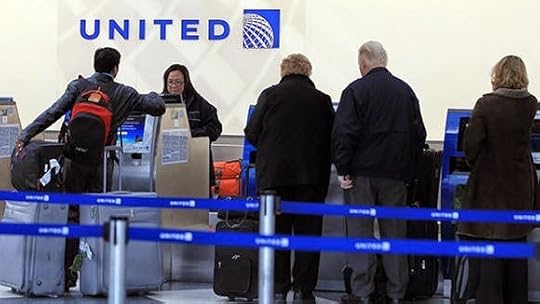
So, I walked back the length of the terminal to the elevator and went up a floor. By now, the sandals I was wearing, i.e. my most comfortable sandals that I've been wearing daily for months with no problems at all, were beginning to hurt. "Just a bit longer," I told myself, "and you'll be in England for nearly a month. A month. You can do this!"
As I got nearer to the United desk, I noticed that they now funneled all passengers through to the automatic check-in machines. I waited in the line for some time before I was finally able to put my passport into the machine and print out a luggage tag, which I then had to apply to my luggage. Then, I got in the long line waiting to approach the desk.
"Do you have your boarding pass?" the United woman asked when I'd finally gotten to the front of the line.
"No. Don't you give me the boarding pass?"
"No. You have to go that machine over there and print out your luggage tag and boarding pass."
"I just printed out my luggage tag. And attached it to my suitcase. See?"
She saw. "Well you should have gotten your boarding pass from the machine at the same time. Go back to the machine you just used and see if it's there."
"Just a bit longer," I told myself , "and you'll be in England for nearly a month. A month. You can do this!"
So back I trudged to the machine. No boarding pass. The passenger using the machine said, "Oh, I saw a boarding pass and handed it to her," nodding towards a United agent nearby.
"Excuse me, but this lady said she handed you my boarding pass. She found it in the machine."
"Oh, yeah," said the agent, "but I can't hold on to them. Company policy is that I destroy all left boarding passes. You'll have to go through the whole process again and reprint another."
What fresh Hell was this? Surely this was a joke. I was on a hidden camera show, right? Or maybe this was all just a bad dream. Well, a nightmare. Praying that morning would dawn and I'd soon wake up, I went through the whole rigmarole with the boarding pass machine again and then lugged all my belongings back into the long line of passengers waiting to approach the desk. My feet were really beginning to hurt now, more specifically my two little toes, which were starting to let me know they weren't happy. I told them to shut up. I wasn't too happy, either.
When it was finally my turn, again, the United rep asked me to put my suitcase on the platform and watched as I struggled with it.
"Can you give me a hand here?" I asked.
"I can't. It's against company policy."
I straightened up and stared at her. "It's against company policy to help your customers? Is that what you're saying?"
"It's a health thing."
A health thing. Really? Cause none of this was doing my blood pressure any good.
The upshot of my finally wrestling Big Red onto the platform was that it was overweight. This again. Sigh. "By seven pounds," the rep said, suddenly wishing to be of some use.
Seven pounds? Had they served Big Red an eight course meal while it rode in the baggage compartment?
"You'll have to go back over there," the United rep said, pointing back at the machines I had just come away from, For the second time. "You'll have to take some stuff out of your luggage until it's at fifty pounds."
"And exactly how will I be able to tell when it's fifty pounds?" I asked.
"There's a scale next to the machine."
"So let me get this straight - I have to tag my own luggage, print my own boarding pass and weigh my own luggage. Is there anything that United Airlines is still prepared to do for it's customers? I mean, I'm not going to be asked to serve drinks on board or to actually fly the plane to London, am I?"
"No, madam, you won't be asked to fly the plane."
"How much would it be if I just paid the overweight fee?"
"Two hundred dollars."
"Two hundred dollars?!"
"I'm sure that if you just take a couple of things out of -"
"Right. Fine. A couple of things. That will then be with me in the cabin rather than with the suitcase in the baggage hold. On the same plane. Same weight. Same plane."
"It's company policy."
"Of course it is. And what's the company motto, Sempre Aggravate?"
"Just a bit longer," I told myself, "and you'll be in England for nearly a month. A month. You can do this!"
So, I went back to the machine (we were on first name terms by this point), laid Big Red down, unzipped her and began to rifle through her guts. I took out one of the boxes of tour stuff and crammed it into my black hand held, along with the computer, camera, nook, power cords and make up it already contained. I took out the tour notebook with all our vital tour documents and stuffed that into my slouchy hobo purse. I took out several other things I thought would weigh the most and stuffed them in various places until both the purse and the black hand held were filled to bursting. And incredibly heavy. Then I went back and waited in line again.
I got the same terrifically helpful agent when I got to the desk. I put my incredibly heavy carry on bags down and wrestled Big Red back onto the platform.
"You're still a bit overweight," the nice lady said.
I stared at her. She stared back. Cue Western gunslinger music.
"Maybe if you just take out something small," she said helpfully.
"And put it where? You only allow two pieces of carry on baggage and both of my bags are already crammed full of stuff."
"Just something small."
I unzipped Big Red and found a sandwich sized baggie that I'd filled with tea bags and removed it.
"There!" the rep said, looking at the scale. "That'll do it."
"Really. Really. An eighth of an ounce made all the difference, did it?"
"You'll be boarding at gate 2,034. Have a nice flight!"
Part Three Coming Soon!
Published on October 13, 2014 00:00
October 10, 2014
TRAVELS WITH VICTORIA: VISITING JOSEPHINE'S GARDENS
Following up on my post about Malmaison of last week (click here), here is more about Josephine and her gardens.
 The Path to Malmaison, near Paris Josephine Bonaparte was famous for her roses, a reputation she carefully cultivated along with her precious blooms. It is widely reported that, even at the height of hostilities, shipments of English roses to the French Empress had special dispensation to pass through both British and French blockades to reach her.
The Path to Malmaison, near Paris Josephine Bonaparte was famous for her roses, a reputation she carefully cultivated along with her precious blooms. It is widely reported that, even at the height of hostilities, shipments of English roses to the French Empress had special dispensation to pass through both British and French blockades to reach her.

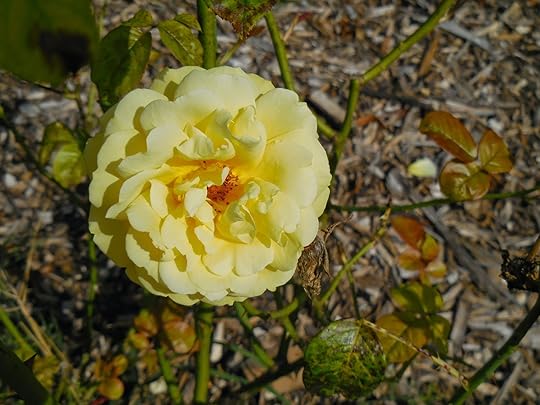 It is also said that Napoleon sometimes had French ships stop and search commercial vessels to find plants for his wife. Although I am certainly not a fan of Napoleon's military career, and I have only a grudging admiration for his administrative achievements (the Civil Code, metric system, etc.), I am endlessly fascinated by the life of Josephine.
It is also said that Napoleon sometimes had French ships stop and search commercial vessels to find plants for his wife. Although I am certainly not a fan of Napoleon's military career, and I have only a grudging admiration for his administrative achievements (the Civil Code, metric system, etc.), I am endlessly fascinated by the life of Josephine.
 Born Marie Josephe Rose Tascher de La Pagerie in 1763 on the Caribbean Island of Martinique, she went to Paris in 1779 at age 16 for an arranged marriage to Viscount Alexandre de Beauharnais. Though they had two children, Eugene (1781-1824) and Hortense (1783-1837), it was not a happy marriage. During the Reign of Terror, Alexandre was guillotined in 1794 but, though imprisoned, Josephine was released.
Born Marie Josephe Rose Tascher de La Pagerie in 1763 on the Caribbean Island of Martinique, she went to Paris in 1779 at age 16 for an arranged marriage to Viscount Alexandre de Beauharnais. Though they had two children, Eugene (1781-1824) and Hortense (1783-1837), it was not a happy marriage. During the Reign of Terror, Alexandre was guillotined in 1794 but, though imprisoned, Josephine was released.

 \
\

 Josephine is reputed to have had an active social and love life in Paris after the Reign of Terror. Napoleon, several years younger than Josephine, fell in love with her and they married in 1796. In 1806 her husband crowned her as Empress and himself as Emperor of the French.
Josephine is reputed to have had an active social and love life in Paris after the Reign of Terror. Napoleon, several years younger than Josephine, fell in love with her and they married in 1796. In 1806 her husband crowned her as Empress and himself as Emperor of the French.


 Although she was already a mother twice over, Josephine failed to provide an heir for the Emperor. The marriage to Napoleon was annulled and Josephine, reluctantly agreeing to the inevitable, came to live at Malmaison for the rest of her life. She died in 1814, after a stroll in these gardens with the Tsar of Russia.
Although she was already a mother twice over, Josephine failed to provide an heir for the Emperor. The marriage to Napoleon was annulled and Josephine, reluctantly agreeing to the inevitable, came to live at Malmaison for the rest of her life. She died in 1814, after a stroll in these gardens with the Tsar of Russia.

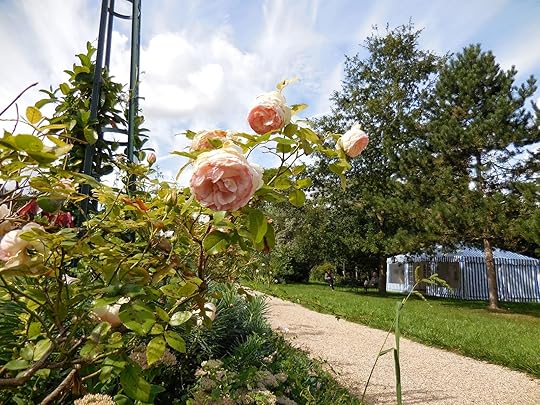
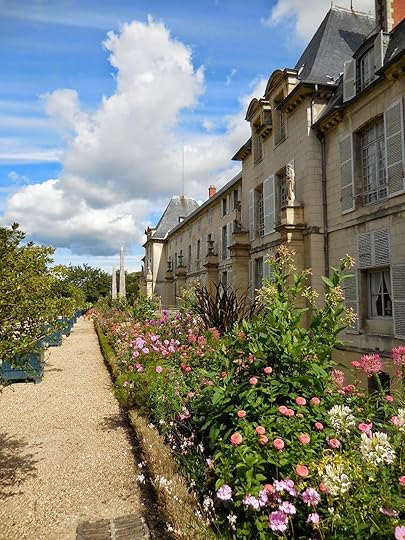
 Napoleon, though he had been as unfaithful to her as she had been to him, loved her until he died. After Josephine's death and after he was defeated the second time and was about to be sent to the remote South Atlantic island of St. Helena, Napoleon returned to Malmaison for a bittersweet parting from his late former wife. It is reported that her name was on his dying lips.
Napoleon, though he had been as unfaithful to her as she had been to him, loved her until he died. After Josephine's death and after he was defeated the second time and was about to be sent to the remote South Atlantic island of St. Helena, Napoleon returned to Malmaison for a bittersweet parting from his late former wife. It is reported that her name was on his dying lips.
 my photo of Josephine statue in Martinique, c.1991 In a bizarre footnote to Josephine's story, her statue in Fort-de-France, capital of her birthplace, Martinique, was beheaded in the early 1990's. The act apparently was to revenge the reports that she had once encouraged Napoleon to restore slavery to the island after it had been revoked for many years. Red paint was splashed on her severed neck and on her gown. As far as I know, the statue stands beheaded today.
my photo of Josephine statue in Martinique, c.1991 In a bizarre footnote to Josephine's story, her statue in Fort-de-France, capital of her birthplace, Martinique, was beheaded in the early 1990's. The act apparently was to revenge the reports that she had once encouraged Napoleon to restore slavery to the island after it had been revoked for many years. Red paint was splashed on her severed neck and on her gown. As far as I know, the statue stands beheaded today.

 So we don't leave Josephine so forlornly, I will add that the Malmaison garden was also full of late-August dahlias. Whether or not she had these blooms in her time, the gardeners of today have given some of them pride of place, perhaps in case the roses are dwindling by the end of summer.
So we don't leave Josephine so forlornly, I will add that the Malmaison garden was also full of late-August dahlias. Whether or not she had these blooms in her time, the gardeners of today have given some of them pride of place, perhaps in case the roses are dwindling by the end of summer.
 Adieu, Malmaison She isShe is reputed to have had an active social and love life in Paris Born Marie Josèphe Rose Tascher de La Pagerie in The garden in late August was brilliant colorful flowers. Roses in all imaginable shades bloomed among many other flowers, particularly dahlias of all varieties. How much it today resembles the garden that Josephine knew is hard to tell, but it is certainly a lovely place. RDOUTE
Adieu, Malmaison She isShe is reputed to have had an active social and love life in Paris Born Marie Josèphe Rose Tascher de La Pagerie in The garden in late August was brilliant colorful flowers. Roses in all imaginable shades bloomed among many other flowers, particularly dahlias of all varieties. How much it today resembles the garden that Josephine knew is hard to tell, but it is certainly a lovely place. RDOUTE
The artist Pierre-Joseph Redoute (1759-1840) painted many of Josephine's roses, said to have included more than 250 varieties.
WHY SHE INTERESTS ME
HER STATUE IN MARTINIQUE ETC.
 The Path to Malmaison, near Paris Josephine Bonaparte was famous for her roses, a reputation she carefully cultivated along with her precious blooms. It is widely reported that, even at the height of hostilities, shipments of English roses to the French Empress had special dispensation to pass through both British and French blockades to reach her.
The Path to Malmaison, near Paris Josephine Bonaparte was famous for her roses, a reputation she carefully cultivated along with her precious blooms. It is widely reported that, even at the height of hostilities, shipments of English roses to the French Empress had special dispensation to pass through both British and French blockades to reach her.

 It is also said that Napoleon sometimes had French ships stop and search commercial vessels to find plants for his wife. Although I am certainly not a fan of Napoleon's military career, and I have only a grudging admiration for his administrative achievements (the Civil Code, metric system, etc.), I am endlessly fascinated by the life of Josephine.
It is also said that Napoleon sometimes had French ships stop and search commercial vessels to find plants for his wife. Although I am certainly not a fan of Napoleon's military career, and I have only a grudging admiration for his administrative achievements (the Civil Code, metric system, etc.), I am endlessly fascinated by the life of Josephine.
 Born Marie Josephe Rose Tascher de La Pagerie in 1763 on the Caribbean Island of Martinique, she went to Paris in 1779 at age 16 for an arranged marriage to Viscount Alexandre de Beauharnais. Though they had two children, Eugene (1781-1824) and Hortense (1783-1837), it was not a happy marriage. During the Reign of Terror, Alexandre was guillotined in 1794 but, though imprisoned, Josephine was released.
Born Marie Josephe Rose Tascher de La Pagerie in 1763 on the Caribbean Island of Martinique, she went to Paris in 1779 at age 16 for an arranged marriage to Viscount Alexandre de Beauharnais. Though they had two children, Eugene (1781-1824) and Hortense (1783-1837), it was not a happy marriage. During the Reign of Terror, Alexandre was guillotined in 1794 but, though imprisoned, Josephine was released.

 \
\
 Josephine is reputed to have had an active social and love life in Paris after the Reign of Terror. Napoleon, several years younger than Josephine, fell in love with her and they married in 1796. In 1806 her husband crowned her as Empress and himself as Emperor of the French.
Josephine is reputed to have had an active social and love life in Paris after the Reign of Terror. Napoleon, several years younger than Josephine, fell in love with her and they married in 1796. In 1806 her husband crowned her as Empress and himself as Emperor of the French.


 Although she was already a mother twice over, Josephine failed to provide an heir for the Emperor. The marriage to Napoleon was annulled and Josephine, reluctantly agreeing to the inevitable, came to live at Malmaison for the rest of her life. She died in 1814, after a stroll in these gardens with the Tsar of Russia.
Although she was already a mother twice over, Josephine failed to provide an heir for the Emperor. The marriage to Napoleon was annulled and Josephine, reluctantly agreeing to the inevitable, came to live at Malmaison for the rest of her life. She died in 1814, after a stroll in these gardens with the Tsar of Russia.



 Napoleon, though he had been as unfaithful to her as she had been to him, loved her until he died. After Josephine's death and after he was defeated the second time and was about to be sent to the remote South Atlantic island of St. Helena, Napoleon returned to Malmaison for a bittersweet parting from his late former wife. It is reported that her name was on his dying lips.
Napoleon, though he had been as unfaithful to her as she had been to him, loved her until he died. After Josephine's death and after he was defeated the second time and was about to be sent to the remote South Atlantic island of St. Helena, Napoleon returned to Malmaison for a bittersweet parting from his late former wife. It is reported that her name was on his dying lips.
 my photo of Josephine statue in Martinique, c.1991 In a bizarre footnote to Josephine's story, her statue in Fort-de-France, capital of her birthplace, Martinique, was beheaded in the early 1990's. The act apparently was to revenge the reports that she had once encouraged Napoleon to restore slavery to the island after it had been revoked for many years. Red paint was splashed on her severed neck and on her gown. As far as I know, the statue stands beheaded today.
my photo of Josephine statue in Martinique, c.1991 In a bizarre footnote to Josephine's story, her statue in Fort-de-France, capital of her birthplace, Martinique, was beheaded in the early 1990's. The act apparently was to revenge the reports that she had once encouraged Napoleon to restore slavery to the island after it had been revoked for many years. Red paint was splashed on her severed neck and on her gown. As far as I know, the statue stands beheaded today.

 So we don't leave Josephine so forlornly, I will add that the Malmaison garden was also full of late-August dahlias. Whether or not she had these blooms in her time, the gardeners of today have given some of them pride of place, perhaps in case the roses are dwindling by the end of summer.
So we don't leave Josephine so forlornly, I will add that the Malmaison garden was also full of late-August dahlias. Whether or not she had these blooms in her time, the gardeners of today have given some of them pride of place, perhaps in case the roses are dwindling by the end of summer.
 Adieu, Malmaison She isShe is reputed to have had an active social and love life in Paris Born Marie Josèphe Rose Tascher de La Pagerie in The garden in late August was brilliant colorful flowers. Roses in all imaginable shades bloomed among many other flowers, particularly dahlias of all varieties. How much it today resembles the garden that Josephine knew is hard to tell, but it is certainly a lovely place. RDOUTE
Adieu, Malmaison She isShe is reputed to have had an active social and love life in Paris Born Marie Josèphe Rose Tascher de La Pagerie in The garden in late August was brilliant colorful flowers. Roses in all imaginable shades bloomed among many other flowers, particularly dahlias of all varieties. How much it today resembles the garden that Josephine knew is hard to tell, but it is certainly a lovely place. RDOUTEThe artist Pierre-Joseph Redoute (1759-1840) painted many of Josephine's roses, said to have included more than 250 varieties.
WHY SHE INTERESTS ME
HER STATUE IN MARTINIQUE ETC.
Published on October 10, 2014 00:30
October 8, 2014
MISCELLANEOUS SNAPS FROM THE DUKE OF WELLINGTON TOUR
By Guest Blogger Denise Costello
When I was traveling recently on The Duke of Wellington Tour, I took approximately 1600 pictures. What to do with all of those pictures? Many of my favorites I have used in two previously posts on my own blog, M. Denise Costello. As a guest on Number One London, I decided to share some of my favorite art and flower pictures from the tour. Enjoy!
I was on my own in London for a couple of days and did lots of walking and sightseeing, and I snapped many flowers and much art on the tour:
[image error] --South Kensington color pop
[image error] --from a park behind the London Eye
[image error] --this park was small but beautiful
[image error] --a green building for sure
[image error] --tree in Green Park
[image error] --rose from the Hyde Park rose garden
[image error] --beautiful purples from Hyde Park
[image error] --whimsical art near Hyde Park
[image error] --wall I passed by (later I found that the grounds of Buckingham Palaceare behind this wall)
[image error] --sculpture in a small park near Victoria Station
[image error] --horses atop the Wellington Arch at Hyde Park Corner
[image error] --on the acres and acres of land behind Buckingham Palace
After leaving London, the tour headed to Kent and the towns of Deal and Dover. Near Deal is Walmer Castle, where the Duke of Wellington resided as a perk of his being appointed Lord Warden of the Cinque Ports by Queen Victoria. The Duke died at Walmer Castle.
[image error] --a corner wall and chair with flowers at Walmer Castle
[image error] --some outside steps with wildflowers growing in the crevices
[image error] --Deal was the cutest town on the channel!
[image error] --from the pier in Deal
[image error] --We visited Dover Castle because it was nearby, even though it was not especially related to the Duke of Wellington.
[image error] --the White Cliffs of Dover and the castle from the harbor
Next we headed to Brighton to see the restoration of a Regency apartment and to visit Brighton Pavilion:
[image error] --in the gardens near Brighton Pavilion
[image error] --different hibiscus
[image error] --greenery near the Pavilion
[image error] --a view of the Pavilion
[image error] --flowers near the Brunswick apartments(we toured a restoration in progress of one of the apartments)
The tour headed to Reading after leaving Brighton, where we visited Stratfield Saye, the Duke of Wellington's country estate. Members of the Duke's family still reside at Stratfield Saye:
[image error] --at a small church on the grounds was an old graveyard
[image error] --statue in from of the beautiful house
[image error] --one of the friends I made on the trip
[image error] --jasmine tree/bush on the Stratfield Saye grounds
[image error] --there was a walled garden at Stratfield Saye
[image error] --climbing roses in the walled garden
We had also visited Highclere Castle (Downton Abbey) and later we visited Windsor and Windsor Castle. I am saving some pics from those adventures for more of my own posts. However, I am exiting this guest post with several pics of the red poppy exhibition that commemorates World War I at the Tower of London:
[image error]
[image error]
[image error]
When I was traveling recently on The Duke of Wellington Tour, I took approximately 1600 pictures. What to do with all of those pictures? Many of my favorites I have used in two previously posts on my own blog, M. Denise Costello. As a guest on Number One London, I decided to share some of my favorite art and flower pictures from the tour. Enjoy!
I was on my own in London for a couple of days and did lots of walking and sightseeing, and I snapped many flowers and much art on the tour:
[image error] --South Kensington color pop
[image error] --from a park behind the London Eye
[image error] --this park was small but beautiful
[image error] --a green building for sure
[image error] --tree in Green Park
[image error] --rose from the Hyde Park rose garden
[image error] --beautiful purples from Hyde Park
[image error] --whimsical art near Hyde Park
[image error] --wall I passed by (later I found that the grounds of Buckingham Palaceare behind this wall)
[image error] --sculpture in a small park near Victoria Station
[image error] --horses atop the Wellington Arch at Hyde Park Corner
[image error] --on the acres and acres of land behind Buckingham Palace
After leaving London, the tour headed to Kent and the towns of Deal and Dover. Near Deal is Walmer Castle, where the Duke of Wellington resided as a perk of his being appointed Lord Warden of the Cinque Ports by Queen Victoria. The Duke died at Walmer Castle.
[image error] --a corner wall and chair with flowers at Walmer Castle
[image error] --some outside steps with wildflowers growing in the crevices
[image error] --Deal was the cutest town on the channel!
[image error] --from the pier in Deal
[image error] --We visited Dover Castle because it was nearby, even though it was not especially related to the Duke of Wellington.
[image error] --the White Cliffs of Dover and the castle from the harbor
Next we headed to Brighton to see the restoration of a Regency apartment and to visit Brighton Pavilion:
[image error] --in the gardens near Brighton Pavilion
[image error] --different hibiscus
[image error] --greenery near the Pavilion
[image error] --a view of the Pavilion
[image error] --flowers near the Brunswick apartments(we toured a restoration in progress of one of the apartments)
The tour headed to Reading after leaving Brighton, where we visited Stratfield Saye, the Duke of Wellington's country estate. Members of the Duke's family still reside at Stratfield Saye:
[image error] --at a small church on the grounds was an old graveyard
[image error] --statue in from of the beautiful house
[image error] --one of the friends I made on the trip
[image error] --jasmine tree/bush on the Stratfield Saye grounds
[image error] --there was a walled garden at Stratfield Saye
[image error] --climbing roses in the walled garden
We had also visited Highclere Castle (Downton Abbey) and later we visited Windsor and Windsor Castle. I am saving some pics from those adventures for more of my own posts. However, I am exiting this guest post with several pics of the red poppy exhibition that commemorates World War I at the Tower of London:
[image error]
[image error]
[image error]
Published on October 08, 2014 00:00
Kristine Hughes's Blog
- Kristine Hughes's profile
- 6 followers
Kristine Hughes isn't a Goodreads Author
(yet),
but they
do have a blog,
so here are some recent posts imported from
their feed.



